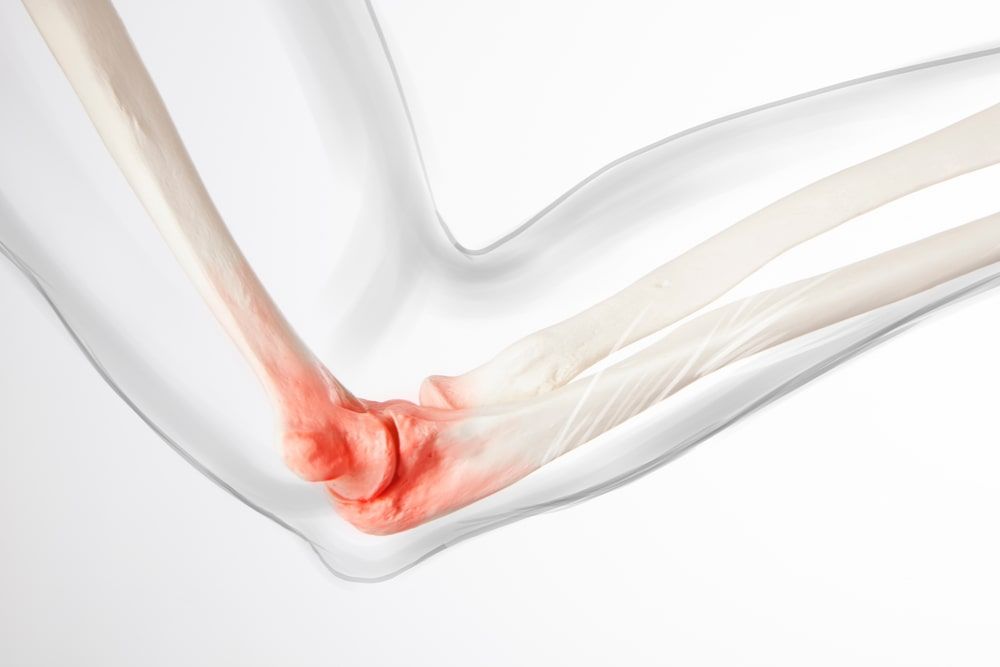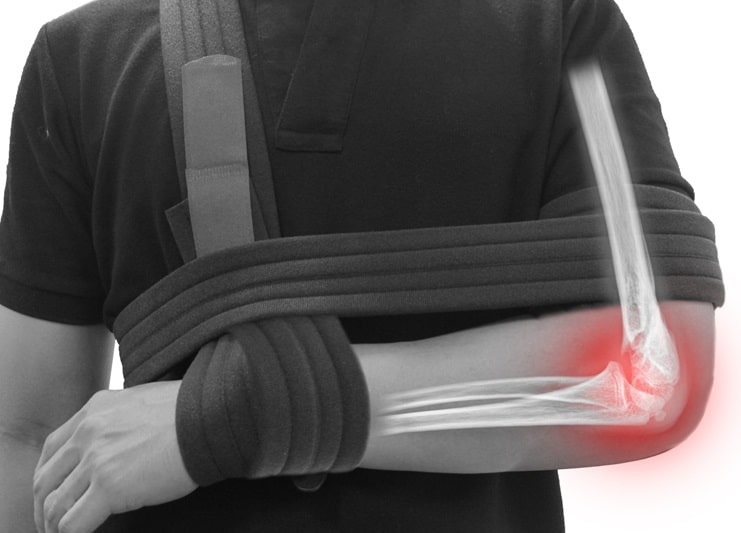This website uses cookies so that we can provide you with the best user experience possible. Cookie information is stored in your browser and performs functions such as recognising you when you return to our website and helping our team to understand which sections of the website you find most interesting and useful.


If you experience an elbow dislocation, seeking medical attention promptly is crucial. Here are some general steps to take before you come to see us:
Stabilize Your Arm: Keep your arm still and avoid moving to prevent further injury or pain.
Immobilize the Elbow: If possible, gently immobilize the elbow joint by using a splint or a makeshift splint. You can use a towel, a piece of clothing, or a rigid object like a rolled-up magazine to support the arm in its current position.
Apply Ice: Applying ice wrapped in a cloth or a cold pack to the affected area can help reduce pain and swelling. Do not apply ice directly to the skin, as it can cause frostbite.
Elevate Your Arm: If possible, elevating the injured arm above heart level can also help reduce swelling.
Signs of Shock: If you turn pale or experience clammy skin, rapid pulse, or shallow breathing, seek medical help immediately. Call 911.
Medical Attention: Elbow dislocations require medical evaluation and treatment to realign the joint and address any associated injuries properly. Do not attempt to reset the elbow joint yourself, as this can cause further damage or complications.
Elbow fractures can occur due to a variety of reasons, such as falls, sports injuries, or trauma.
Your elbow joint consists of three bones: the humerus (upper arm bone), the ulna, and the radius (two bones of the forearm). Fractures can affect any of these bones.
There are different types of elbow fractures, including:
Radial Head Fractures: Involve the head of the radius bone and can range from small cracks to complete breaks.
Olecranon Fractures: The olecranon is the bony tip of the elbow. Fractures here can result from direct blows or falls onto the elbow.
Radial Neck Fractures: These occur near the elbow joint and can sometimes lead to complications with the nerves and blood vessels around the area.
Coronoid Fractures: The coronoid process is a part of the ulna bone and is essential for elbow stability. Fractures here can affect the strength and movement of the joint.

Once our medical professionals assess your dislocation, they may perform a reduction procedure to put your elbow joint back into its proper position. Depending on the severity of the dislocation and any accompanying injuries, additional treatments such as immobilization with a splint or cast, physical therapy, or surgery may be necessary for recovery.
Elbow fractures can occur from a variety of causes, including:
Trauma: Direct trauma to the elbow from falls, sports injuries, motor vehicle accidents, or other accidents is a common cause of fractures. Impact or force applied to the elbow joint can lead to bone fractures.
Falls: Falling onto an outstretched hand with the arm extended can transmit significant force to the elbow joint, resulting in fractures of the bones comprising the elbow.
Sports Injuries: Participating in sports that involve contact, high-impact movements, or repetitive stress on the elbow joint can increase the risk of fractures. Activities such as football, basketball, gymnastics, or martial arts may lead to elbow fractures due to collisions, falls, or overuse injuries.
Overuse or Repetitive Stress: Activities involving repetitive motions of the elbow joint, such as throwing, pitching, or repetitive lifting, can lead to stress fractures or overuse injuries over time. These fractures may develop gradually due to cumulative stress on the bones.
Osteoporosis: Osteoporosis, a condition characterized by weakened and brittle bones, increases the risk of fractures throughout the body, including the elbow. Fragile bones are more susceptible to fractures, even with minor trauma or falls.
Age-related Changes: As people age, their bones may become weaker and more prone to fractures. Older adults may experience fractures more quickly due to factors such as decreased bone density, muscle weakness, and changes in balance and coordination.
Medical Conditions: Certain conditions or diseases, such as bone tumors, metabolic bone disorders, or genetic conditions affecting bone strength, can increase the risk of elbow fractures.
Bone Infections: Infections of the bone (osteomyelitis) can weaken the bone structure, making it more susceptible to fractures. Fractures associated with bone infections often require prompt medical treatment to prevent further complications.
Genetic Factors: In some cases, genetic factors may contribute to a patient’s susceptibility to bone fractures, including those affecting the elbow.
Preventing elbow fractures involves practicing safety measures during physical activities, maintaining good bone health through proper nutrition and exercise, using protective equipment when engaging in high-risk activities, and seeking prompt medical attention for any signs of injury or trauma to the elbow joint.
An elbow dislocation can occur when the elbow joint bones are forced out of their normal position. This can happen due to various causes, including:
Trauma or Injury: The most common cause of elbow dislocations is trauma or injury, such as falls onto an outstretched hand, direct blows to the elbow, or high-impact accidents. These traumatic events can force the bones of the elbow out of alignment.
Sports Injuries: Participating in sports activities that involve contact, collisions, or high-impact movements can increase the risk of elbow dislocations. Sports such as football, rugby, wrestling, or gymnastics may lead to elbow dislocations due to falls, tackles, or awkward landings.
Motor Vehicle Accidents: Collisions or sudden decelerations in motor vehicle accidents can exert significant force on the arms and elbows, potentially causing elbow joint dislocation.
Overextension: Hyperextension of the elbow joint beyond its normal range of motion can cause ligaments and other soft tissues to become stretched or torn, leading to elbow dislocation.
Repetitive Stress: Overuse or repetitive stress on the elbow joint, such as repeated throwing motions in sports like baseball or javelin throwing, can weaken the elbow’s supporting structures over time, increasing the risk of dislocation.
Congenital Factors: Some patients may have congenital or developmental abnormalities in the structure or alignment of their elbow joints, which can predispose them to dislocations or instability.
Seizures or Falls: Seizures or sudden loss of consciousness can lead to falls, during which the arms may be extended to break the fall. This can result in significant force being applied to the elbows, potentially causing dislocation.
Joint laxity: Due to increased joint laxity and instability, individuals with naturally loose or hypermobile joints may be more prone to elbow dislocations.
Elbow dislocations are often accompanied by symptoms such as severe pain, swelling, deformity, and limited range of motion. Prompt medical evaluation and treatment are essential to realign the elbow joint and address any associated injuries, such as fractures or ligament tears.
Rehabilitation and physical therapy may be necessary to restore the affected elbow’s strength, stability, and function.
Treatment for an elbow fracture depends on several factors, including the type and severity of the fracture, the patient’s age, overall health, and activity level. Here are some common treatments for elbow fractures:
Immobilization: Many elbow fractures can be treated by immobilizing the elbow joint with a splint, sling, or cast to keep the bones in proper alignment while they heal. Immobilization helps prevent further injury and allows the bones to fuse together correctly.
Closed Reduction: Sometimes, you may need a closed reduction procedure to realign the fractured bones without surgery manually. This may involve applying traction and gentle manipulation to maneuver the bones back into their correct positions.
Surgery: Severe or complex elbow fractures may require surgery to realign the bones and stabilize the joint. This can involve techniques such as internal fixation (using metal plates, screws, or pins to hold the bones together) or external fixation (using a device outside the body to stabilize the bones).
Physical Therapy: Following immobilization or surgery, physical therapy is often recommended to restore the elbow joint’s range of motion, strength, and function. A physical therapist will prescribe exercises and rehabilitation techniques tailored to the patient’s specific injury and recovery goals.
Pain Management: Pain management strategies, such as over-the-counter or prescription pain medications, may be recommended to help alleviate discomfort during the healing process.
Activity Modification: Patients with elbow fractures may need to modify their activities or temporarily avoid specific movements that could exacerbate their injury. Following medical advice regarding activity restrictions and modifications is vital for optimal healing.
Follow-up Care: Regular follow-up appointments are necessary to monitor the healing progress and make any necessary adjustments to the treatment plan.
Bracing or Splinting: Depending on the type and location of the fracture, a brace or splint may be used during the healing process to provide additional support and protection to the elbow joint.
Treatment for a dislocated elbow involves managing pain, realigning the joint, and promoting healing. Treatments for elbow dislocations:
Immediate Medical Attention: Promptly after a suspected elbow dislocation. Do not attempt to relocate the joint yourself, as this can cause further damage. Immobilize your arm with a splint or sling to prevent movement and further injury while awaiting medical assistance.
Reduction: The dislocated elbow will be reduced in the emergency department, which means putting the bones back into their proper positions. This may involve gentle manipulation or traction techniques to realign the joint.
Pain Management: Pain associated with an elbow dislocation can be severe. Pain management techniques, such as over-the-counter or prescription pain medications, may be prescribed to alleviate discomfort during the healing process.
Immobilization: Following reduction, the elbow may be immobilized with a splint, sling, or brace to stabilize the joint and allow the surrounding tissues to heal. The period of immobilization is typically determined by the severity of the dislocation and the individual’s response to treatment.
Physical Therapy: Once the acute pain and swelling subside, physical therapy is often recommended to restore the elbow joint’s range of motion, strength, and function. A physical therapist will prescribe exercises and rehabilitation techniques tailored to patients’ specific injury and recovery goals.
Follow-up Care: Regular follow-up appointments are necessary to monitor the healing progress and make any necessary adjustments to the treatment plan. X-rays may be taken periodically to assess the alignment of the joint and ensure that healing is progressing as expected.
Surgery: In some cases of severe elbow dislocations or associated fractures, surgery can be necessary to repair damaged ligaments, remove loose bone fragments, or stabilize the joint. Surgery may involve techniques such as internal fixation (using metal implants) or ligament reconstruction.
Activity Modification: Patients with elbow dislocations may need to modify their activities or temporarily avoid certain movements that could exacerbate their injury. Following medical advice regarding activity restrictions and modifications is vital for optimal healing.
There are several surgical options based on the type and severity of your elbow injury and your overall health. Dr. Stephen W. Pournaras Jr. will discuss your options and help you decide which is best for you.
Most surgeries are followed by elbow therapy, which strengthens the muscles and improves function. We also offer this therapy.
Mon 8:00 am – 4:30 pm
Tue 8:00 am – 4:30 pm
Wed 8:00 am – 4:30 pm
Thu 8:00 am – 4:30 pm
Fri 8:00 am – 4:30 pm
Sat Closed
Sun Closed

